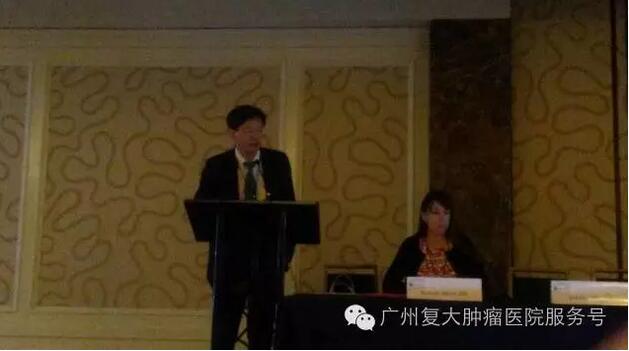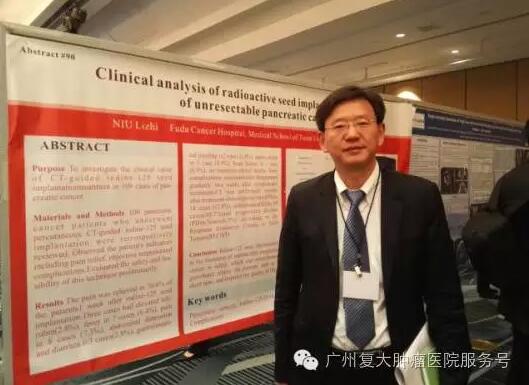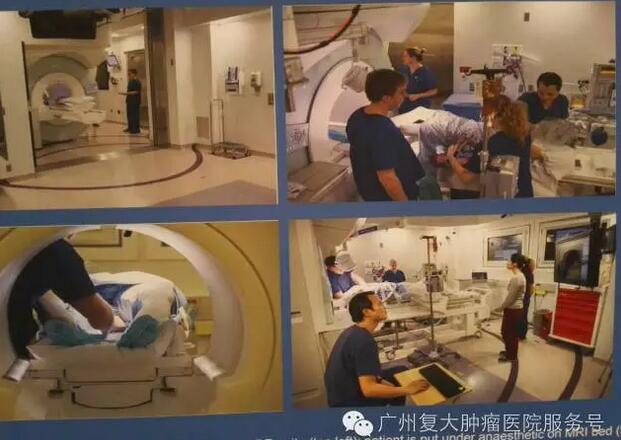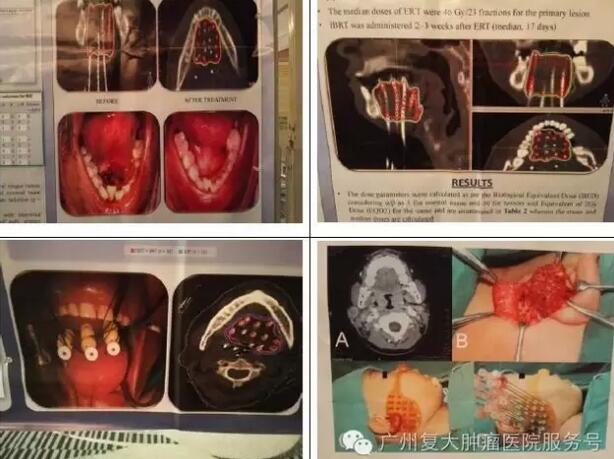June 28th, 2016, the second day of the 2016 ABS World Congress-American Brachytherapy Society, was the time for Chinese experts to demonstrate the development of brachytherapy in China. The congress has witnessed the speeches of over 10 Chinese medical experts and 20 wall posters. The original research in China has gained the word’s attention. In particular, the scientific literacy and Englishproficiency of Chinese doctors are inspiring. I firmly believe that the development of brachytherapy for cancer holds a bright future in China.

CIBS members and chairman of the congress
On the same day, Prof. Zhang Fujun, Prof. Wang Junjie and Prof. Zhang Jianguo from Interventional Brachytherapy Branch, Committee of Minimally Invasive Therapy in Oncology, Chinese Anti-cancer Association established official relations with ABS, which has for the first time secured China’s Brachytherapy Society’s place in the world arena. It is fair to say that the day is a milestone in the history of brachytherapy in China.
Expert meetings
ABS World Congress-American Brachytherapy Society and CIBS held their first official meeting in San Francisco on June 28th, 2016. Prof. David Gaffney, incumbent chairman of ABS/WCB, Prof. Steven Frank, former chairman of ABS/WBC, Secretary Ms. Cate Yashar, CFO Firas Mourtada, the executive director Mr. Rick Guggolz met the incumbent chairman Prof. Zhang Fujun, former chairman Prof. Wang Junjie, vice-chairman Prof. Zhang Jianguo, after-loading therapy expert Prof. Cheng Guanghui of Interventional Brachytherapy Branch, Committee of Minimally Invasive Therapy in Oncology, Chinese Anti-cancer Association and discussed matters, including cooperation, exchange visits, young doctor training, etc.
Prof. Wang Junjie delivered a speech titled “China Brachytherapy Update-Current Situation & Prospectives”, introducing to the audience the status quo of Brachytherapy in China, 3D Printing Individual Templates Guided Brachytherapy and technology promotion. Prof. Zhang Fujun briefed to the participants the achievements made in the field of brachytherapy in China in the past ten years and more, especially the innovations made in radioactive particle stent and 3D printing.

Experts from other countries spoke highly of the innovation spirit of Chinese doctors shown in developing radioactive particle stent, 3D printing and rapid degradation particle chain and have tentatively reached an accord that a special session on seed implantation therapy will be set up for Chinese experts at the next session of forum to be held in Boston in April 2017. Moreover, several leaderships and experts from foreign Societies will be invited to attend China Academic Conference on Seed Implantation for Cancer or China Congress of Brachytherapy for enhanced communication and understanding to make World Congress of Brachytherapy to be held in China.
Congress summery
June 28th, 2016 was the day for Chinese experts to demonstrate the development of brachytherapy in China. At the congress, 10 delegates from Chinese delegation delivered speeches and 20 wall posters were put up, which have gained the word’s attention. In particular, the scientific literacy and Englishproficiency of Chinese doctors are quite inspiring.


Prof. Niu Lizhi, Jinan University School of Medicine affiliated Fuda Cancer Hospital delivered a speech and had his paper posted
At the congress, several Chinese experts showed to the participants the research on radioactive seeds for solid tumors. Prof. Wang Juan from Hebei General Hospital reported the research on radioactive seeds implantation therapy for retroperitoneal tumor. Prof. Li Yuliang from the Second Hospital of Shandong University reported the research on seed implantation therapy for pancreatic cancer. Prof. Niu Lizhi from Jinan University School of Medicine affiliated Fuda Cancer Hospital reported radioactive seeds implantation therapy for cardiac tumor and pancreatic tumor. In addition, the reports delivered by experts from Tianjin Medical University, Jiangsu Province Hospital, Chinese PLA General Hospital have gained extensive attention from the participants.
In recent years, China has made significant development in the field of radioactive seeds implantation therapy for cancer. The innovative research and superb achievement made by Chinese experts can be shown in the following aspects:
1、Seed chain
An US study shows that when it comes to seed implantation in the prostate cancer, the rate of seed displacement to lung by using particle chain is much lower than that of chainless seed implantation. Moreover, using particle chain has guaranteed the uniform distribution of the seeds and the dosage also, which is the main reason why doctors from the US give preference to particle chain. The degradation of particle chain needs 90 days. In comparison, the degradation of particle chain material, a patent owned by Prof. Zhang Fujun from China only takes 10 days. Medical experts showed great interest in the new material, hoping that Prof. Zhang Fujun could commercialize it in the shortest term.
2、MR
The focus of the current session of conference is that many hospitals in the US have been performing brachytherapy under MR guidance especially for pelvic organ tumors in that MR is the most accurate imaging examination for pelvic organs, such as prostate, uterine neck, rectum and anus. Brachytherapy for tumors in these organs requires precise positioning. MR-guided brachytherapy has just started in China. Prof. Li Chengli from Shandong Medical Imaging Research Institute is an authoritative expert in MR-guided brachytherapy. We believe with his effort, MR-guided brachytherapy will be more and more widely used in China.
3、Brain tumor
An American hospital carried out a research where radioactive seeds are inserted into the surrounding tissue after primary brain tumor resection in order to prevent tumor recurrence. The research showed that radioactive seed implantation in the surrounding tissue after primary tumor resection can reduce the recurrence rate of tumor. Prof. Hu Xiaokun, chairman of Image Technology Branch, Committee of Minimally Invasive Therapy in Oncology, Chinese Anti-Cancer Association, has made remarkable achievement in the field of seeds implantation for brain tumor. Regrettably, he didn’t make it to attend the current session of congress. We hope he could attend the next session of congress to show to the world his research achievement.

Indian experts carried out research on radioactive seeds for head and neck tumor
4、Head and neck tumor
Head and neck tumor are the tumors of the highest incidence rate in India. The application of high dose rate Iridium-192 has achieved good curative effect as it is shown in the pictures below. The team of professors represented by Prof. Zhang Jianguo has made the most brilliant achievement in the field of brachytherapy for head and neck tumor. The clinical result and research achievement in brachytherapy for neck and head tumor are leading the world and have gained the attention of the participating experts.

Indian experts carried out research on radioactive seeds for head and neck tumor
5、Vertebral tumor
Vertebrae are the most common site of metastases. Applying radioactive I-125 seeds implantation on metastatic vertebral tumor after failure of radiotherapy or when radiotherapy is not applicable is the innovation made by Chinese medical experts. Both team of professors represented by Prof. Wang Junjie from Peking University Third Hospital and team of professors represented by Prof. Huang Xuequan shared with the participants their experience and research on radioactive seeds for vertebral tumors, the good therapeutic effect of which has gained the attention of foreign experts.
6、Lung cancer
At the current session of forum, the only research report on brachytherapy for lung cancer was made by the team of professors represented by Prof. Zhang Fujun from Sun Yat-sen University. They reported the significant efficacy of radioactive I-125 seeds implantation for metastatic lung cancer and primary and unresectable lung tumors as well as the significant increase of local control rate and prolongation of survival time. The study was published in Radiology-the top magazine in interventional treatment.
7、Radioactive seeds stent
The team of professors represented by Prof. Guo Jinhe from Southeast University reported the research results of animal experiment and clinical studies on radioactive seeds stent for tracheal-caused stenosis. The strategy has not only solved the problem of tracheal stenosis but also enabled the radioactive seeds to treat cancer, which has prevented tumor recurrence and effectively prolonged the survival time of cancer patients. The study was published in the well-known magazine Lancet Oncology.
Low-dose-rate seed VS high-dose-rate seed: each has its own strength
In the US, high-dose-rate seeds (including Palladium-103, Iridium-192) are used to treat solid tumors, prostate cancer excluded. High-dose-rate seeds can be taken away within a short period of time after radiating the tumor tissue, which can be classified into temporary seed implantation. In comparison, low-dose-rate seeds have to be implanted in the tumor for a long term, which falls into the category of permanent seed implantation. The advantages of temporary seed implantation are short irradiation time and good short-term effect though it also has its downside. Prof. Wang Juan from Hebei General Hospital noted that the protection of high-dose-rate seed is more difficult than that of the low-dose-rate one, which better suits Chinese condition. The advantage of low-dose-rate is that the total irradiation dosage can be increased. According to research from Japan, good tolerance is noted when prostate cancer patients were given I-125 seeds implantation, the radioactivity of which is up to 200GY. It also shows the safety of low-dose-rate seed implantation.
In a nutshell, both low-dose-rate seed and high-dose-rate seed have their own strength and are suitable for different tumors. We hope that seeds with different dose rates will be available for cancer patients in China.